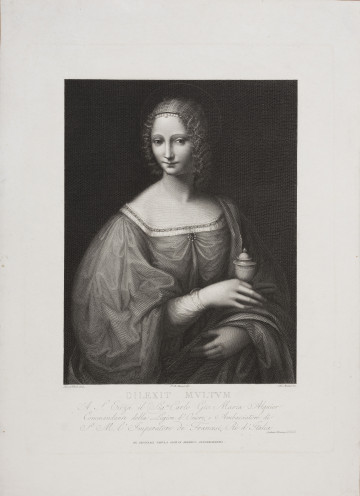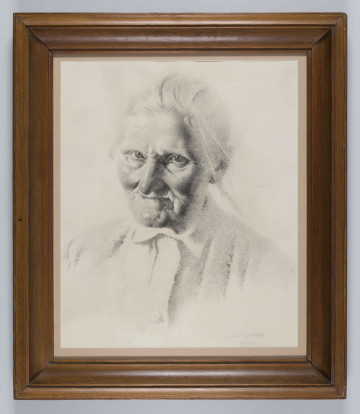
St. Mary Magdalene
1805 — 1814
National Museum in Szczecin
Part of the collection: Dutch and Flemish graphics
The portrait of Marguerite de Lorraine, Duchess of Orléans (1615-1672), half-length, proves that this portrait was intended for a less representative purpose than its full-length original from around 1634, by Anthony van Dyck (1599-1641), located in the Uffizi Gallery in Florence. The engraving was part of the Icones Principum Virorum series, which included reproductions of van Dyck’s paintings of well-known personalities. Originally published with the address of Martin van den Eden, it was later published in the Gillis Hendricks printing company. The copperplate is currently stored in Chalcographie du Louvre in Paris. Compared to van Dyck’s copperplate oil painting by Schelte Bolswert (about 1586-1659), the elements of Marguerite’s clothing were changed: the dress gained a white insert with scalloped edging under the bust, prominent cuffs and a collar sewn along the rim, which was of intricate lace in the original work; puffed sleeves with a different cut and adorned with large bows. Moreover, the pearls in the original work adorn only the neck of the duchess, who holds a rose in her hand, slightly above her waist, whereas on the engraving an additional string of pearls is flowing from her arm to the ribbon rosette attached to her bust, and the duchess’s empty hand is resting on her lap. Marguerite de Lorraine was the daughter of Francis II (1571-1632), Duke of Lorraine, a country then in conflict with France. In 1629 her family hosted Gaston the France (1608-1660), Duke of Orleans, younger brother of the then King of France, Louis XIII (1601-1643), after one of his numerous failed schemes. Gaston, taken by the duchess’s innocence, fell in love with her at first sight. Only with the blessing of the duke’s mother, Marie de’ Medici (1575-1642) and without Louis XIII knowing, the couple was secretly married on 2 January, 1632, which they kept secret only until November. The marriage was considered null by the king and the parliament of France, despite its second conclusion in the Spanish Netherlands. Only shortly before his death did Louis XIII accept the relationship between Gaston and Marguerite, who eventually took their marriage vows for a third time in May 1643. Marguerite, distancing herself from courtly life and politics, secured her place among the few women portraits in Iconography through marital connections, posing for van Dyck most likely together with her mother-in-law and her husband during their stay in Brussels.
Ewa Gwiazdowska
Author / creator
Object type
chalcography (print), reproductive prints
Technique
copper engraving
Material
ribbed laid paper
Origin / acquisition method
acquisition
Creation time / dating
Creation / finding place
Owner
Muzeum Narodowe w Szczecinie
Identification number
Location / status

1805 — 1814
National Museum in Szczecin

1852
National Museum in Szczecin

1936
National Museum in Lublin
DISCOVER this TOPIC
Museum of King Jan III's Palace at Wilanów
DISCOVER this PATH
Educational path